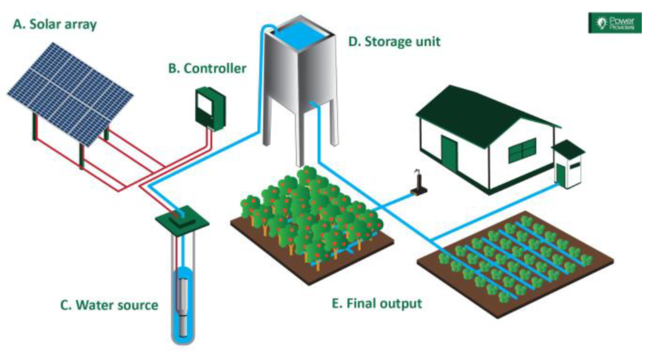Solar water pumps are very important when you want to supply water beyond the reach of power lines. But do you know how they work? We tell you how a solar water pump works:
Solar water pump working principle
The system operates on power generated using solar PV (photovoltaic) system. The photovoltaic array converts the solar energy into electricity, which is used for running the motor pump set.
Solar water pumps are specially designed to utilize DC electric power from photovoltaic modules. The pumps must work during low light conditions, when power is reduced, without stalling or overheating. Low volume pumps use positive displacement (volumetric) mechanisms which seal water in cavities and force it upward.
A surface pump is one that is mounted at ground level. Surface pumps work well when they draw water through suction less than 10 or 20 feet. A submersible pump is one that is lowered into the water. Most deep wells use submersible pumps.
A pump controller (which is a linear current booster) is an electronic device used with most solar pumps. It acts like an automatic transmission, helping the pump to start and keeps it from stalling in weak sunlight. Some controllers also have additional features such as offering terminal for the float switch to shut off the pump when a storage tank is full and protection for overvoltage conditions.
A solar tracker may be used to tilt the PV array as the sun moves across the sky during the day. This can increase daily energy gain by as much as 55%. With more hours of peak sun, a smaller pump and power system may be used.
Tracking works best in clear sunny weather. It is less effective in cloudy climates and on short winter days. However, in the last several years the cost of solar panels has come down so much that it is usually more cost effective to add more solar panels than to add a tracker. Additionally, since the tracker have moving parts they will tend to need repair after several years.
Storage is important. Three to ten days’ storage may be required, depending on climate and water usage. Most systems use water storage tanks for simplicity and economy. In other cases, batteries can be added to the system.
Electrical energy from the solar modules is stored in the deep cycle batteries so that the pump can run at non-sunny times. Add a float switch to the system which can turn the pump off when the water tank fills, to prevent overflow.
Windmills, used to pump water in the “old” days, can still be seen on many horizons. More recently solar pumps have replaced windmills in water pumping applications. A small solar system turns out to be less expensive and much easier to install and maintain.
The solar panels also provide a more consistent supply of water; and they can be installed in valleys and wooded areas where wind exposure is poor. A PV array may be placed some distance away from the pump itself; even several hundred feet (100 m) away.
Advantage and disadvantage of solar water pumping system
One great advantage of a solar water pump is zero fuel cost however, for pump to work effectively you would need an area where there is plenty of sunlight. Solar energy storage is also expensive. Initial cost of installing a solar water pumping system is also high.
And that is how a solar water pump works; its advantages and disadvantages.
Also Read
Installation of water meters: Instructions and Guidelines
Diesel generator troubleshooting & maintenance tips

